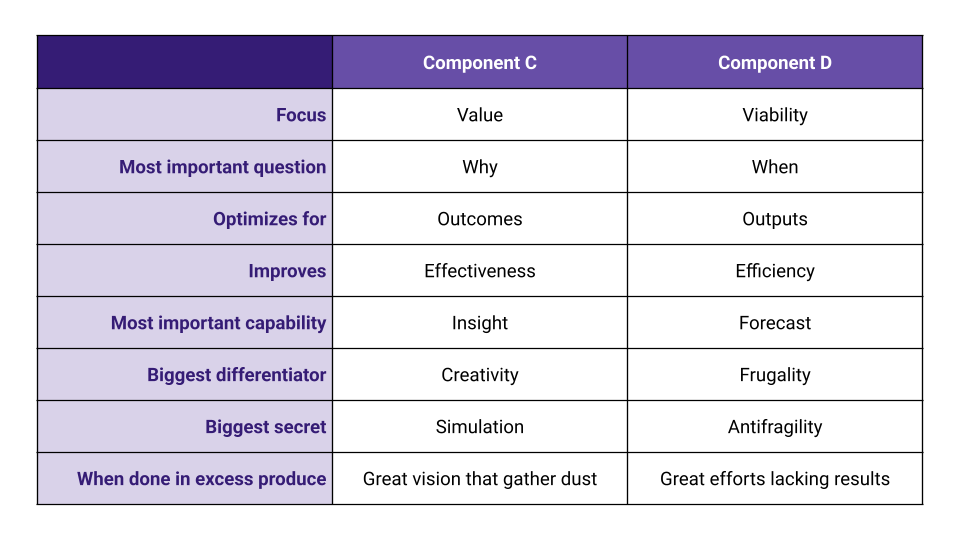Experience Delivery: The System Behind Turning Vision into Reality (5/8)
Turning that envisioned future into reality — the outputs and what’s necessary below the surface.

In my previous post about Experience Architecture, I introduced the concept of designing the future through a strong product vision. But there's more to the story. So before exploring Component D of the Product Excellence Architecture — the system for building the product right — I want to put three critical forces that shape how vision translates into reality in perspective: Vision Velocity, Experience Debt, and Vision-Operation Fit.
Vision Velocity: The Speed of Future-Building
Vision Velocity isn't about how fast you can build features. It's about how quickly your organization can move toward its envisioned future.
Think of Vision Velocity as a vector, not just a speed measurement. It has both magnitude and direction. High feature velocity pointing in the wrong direction actually takes you further from your vision.
Factors Affecting Vision Velocity
Vision Clarity
How clearly can team members articulate the vision?
Do different teams share the same understanding?
Can people connect daily decisions to the larger vision?
Operational Alignment
Do your processes support or hinder vision progress?
Are your metrics measuring vision progress or just activity?
Does your organizational structure facilitate vision-aligned decisions?
Resource Allocation
Are investments aligned with vision priorities?
Do teams have the right capabilities to move toward the vision?
Is technical debt being managed in vision-critical areas?
Experience Debt: The Hidden Cost of Short-Term Thinking
Just as technical debt accumulates when we take shortcuts in code, Experience Debt accumulates when we compromise on user experience to meet short-term goals. But while technical debt is visible to developers, Experience Debt often remains hidden until it's too late.
Types of Experience Debt
Consistency Debt
Inconsistent interaction patterns
Fragmented user flows
Conflicting design languages
Context Debt
Features that solve immediate problems but ignore larger user context
Disconnected experiences that force users to maintain mental models
Solutions that don't scale with user growth
Promise Debt
Features that don't fully deliver on the product's core promise
Experiences that create expectations you can't maintain
Short-term solutions that delay delivering on your vision
Vision-Operation Fit: The Bridge Between Dreams and Reality
Vision-Operation Fit measures how well your operational capabilities align with your vision ambitions. It's about having the right capabilities to deliver on your vision promises.
Assessing Vision-Operation Fit
Capability Mapping
Current vs. Required Technical Capabilities
Team Skills and Knowledge
Process Maturity
Resource Availability
Gap Analysis
Identifying Critical Capability Gaps
Prioritizing Gap Closure
Building vs. Buying vs. Partnering Decisions
Growth Planning
Capability Development Roadmap
Training and Hiring Plans
Process Evolution Strategy
These three forces - Vision Velocity, Experience Debt, and Vision-Operation Fit - are constantly interacting. High Experience Debt can slow Vision Velocity. Poor Vision-Operation Fit can lead to more Experience Debt. Understanding these interactions is crucial for product leaders.
As your product and organization evolve, these forces become increasingly important. Managing them well is often the difference between visions that inspire and visions that expire.
Now let me talk about the Component D…
Backward Logic in a Logic Model: From Impact to Inputs
When designing a product, it is often more effective to start with the desired impact and work backward to identify the necessary outcomes, outputs, activities, and resources. This approach ensures that every step contributes directly to achieving meaningful change.
Using an "if... then..." reasoning, the backward logic model of the backbone follows this structure:
Impact (Long-Term Change in Systems, Organizations, or Communities)
What is the ultimate transformation we want to see?
If we want to create this systemic change, then we must ensure that individuals or groups benefit in specific ways.
Outcomes (Changes in Behavior, Knowledge, or Condition for Users)
What measurable benefits must users experience to drive the intended impact?
If participants achieve these outcomes, then it means they must have received the necessary products, services, or interventions.
Outputs (Products, Services, or Deliverables Provided to Users)
What tangible outputs must be delivered to ensure the desired outcomes?
If we want to generate these outputs, then we must perform the right activities.
Activities (Actions Taken to Produce Outputs)
What key actions or processes or work must be executed to create the necessary outputs?
If we need to carry out these activities, then we must secure the required inputs.
Inputs/Resources (Resources Needed to Execute the Work)
What financial, human, and material resources are essential for implementing the activities?
If we need these inputs, then we must plan for their availability and allocation efficiently.
At the heart of Experience Delivery is the principle of working backwards. This isn’t just a catchy phrase; it’s a disciplined approach to execution. It starts with the desired impact and outcomes provided by the Vision (Component C) and works backward to identify the necessary outputs, activities, and resources. This ensures that every step taken contributes directly to achieving meaningful change.
This backward-working logic ensures alignment between Vision and Execution. It prevents the common pitfall of building outputs that don’t connect to outcomes or investing in activities that don’t move the needle.
The component D, building the product right
Together with component C, this strategic system forms the foundation for tactical operations in your product development cycle (E). As I said in previous posts, Experience Architecture (C) and Vision Building (D) aren't just high-level frameworks—they're strategic systems that directly enable tactical operations in your product development cycle. While component C helps you design the future experience through vision and prototypes, component D transforms this vision into an operational plan for the present. Together, they create a continuous feedback loop that guides your tactical decisions in the product development cycle (E).
Let’s recap the main aspects of each strategic component:
Experience Delivery is about building the bridge to the future. It’s the engine that transforms vision into reality, the system that ensures the desired impact isn’t just a dream but a tangible product that becomes an experience when people use it. And like any well-designed system, it has its own logic, its own triangulation, and its own method of operation.
The Triangulation of Experience Delivery
Just as Experience Architecture relies on a triangulation of ambition, creativity, and operational capabilities, Experience Delivery operates through its own triangulation of capabilities, scope, and strategic vision. These three elements form the pillars of the execution plan, ensuring that the Vision is not only realized but sustained over time.
These three elements—Capabilities, Scope, and Strategic Vision—don't exist in isolation. They interact dynamically:
Capabilities shape Scope: What you can do defines what you will do
Scope refines Strategic Vision: Practical constraints inform strategic thinking
Strategic Vision expands Capabilities: Ambitious goals drive skill development
Component D transforms this vision into reality – it's where the story becomes action. This phase will rely heavily (80%) on the Work and Team aspects of the Backbone, focusing on the processes, collaboration, and execution required to bring the vision to life. Only 20% will be based on Impact and Usage, as these aspects have been thoroughly considered in the "design" phase.
When Experience Delivery is disconnected from Experience Architecture, the results can be disastrous. Great efforts may be expended, but without alignment to the Vision, they lack direction and fail to produce meaningful change. This is why the working-backwards approach is so crucial—it ensures that every output, activity, and resource is tied to the ultimate goal.
Conversely, when Experience Delivery is overemphasized at the expense of Vision, the system becomes a treadmill—lots of motion but no progress. The key is balance. Vision provides the destination; Execution builds the path.
This triangulation creates a feedback loop, where outputs inform activities, activities shape resource allocation, and resources enable better outputs. It’s a dynamic system that adapts to changing conditions while staying focused on the ultimate goal.
The Hidden Mechanics: Antifragility and Frugality
Beneath the surface of Experience Delivery lies a set of principles that keep the system running smoothly. Two of the most critical are antifragility and frugality.
Antifragility: Execution is inherently messy. Plans go awry, unexpected challenges arise, and failures happen. An antifragile system doesn’t just withstand these disruptions; it grows stronger from them. It learns, adapts, and evolves, turning setbacks into opportunities for improvement.
Frugality: In a world of limited resources, frugality is a virtue. It’s not about cutting corners but about maximizing impact with minimal waste. Frugality forces prioritization, ensuring that every resource is used effectively and that every activity contributes to the desired outcomes.
Measuring the Health of Experience Delivery: Is Your Execution System Working?
Unlike traditional metrics that measure output volume or speed, the health of Experience Delivery lies in its alignment, resilience, and ability to convert resources into meaningful outcomes. Here’s how to diagnose it:
The Backward-Working Alignment Score: Start by evaluating how tightly your execution system connects to the Vision (Component C). Use this checklist:
Outcome-to-Output Linkage: Are ≥80% of your outputs directly traceable to the outcomes defined in the Vision?
Resource-to-Activity Efficiency: What percentage of resources (time, budget, talent) are allocated to activities that drive vision-aligned outputs?
Healthy threshold: >70%. Lower scores signal misalignment or waste.Vision Clarity Index: Survey teams. Can they articulate how their work contributes to the Vision? A score below 8/10 indicates a leaky execution pipeline.
Antifragility Quotient: Execution systems thrive under pressure—if they’re built to learn from chaos. Measure antifragility by:
Failure-to-Adapt Ratio: Track how many setbacks (e.g., missed deadlines, technical failures) resulted in process improvements or capability upgrades.
Warning sign: A ratio <1:1 (more failures than adaptations) suggests brittleness.Feedback Loop Speed: How quickly does frontline execution data (e.g., user complaints, team blockers) inform adjustments to activities or resource allocation?
Ideal: Days, not quarters.
Experience Debt Audit: Experience Debt is the silent killer of execution. Quantify it with:
Consistency Score: Audit user journeys. What percentage of interactions follow coherent design patterns? <90% signals mounting debt.
Promise Fulfillment Gap: Compare what your product promises (via marketing, UX) to what it delivers. A gap >20% means you’re accumulating trust debt.
Context Drift: Are new features solving isolated problems or contributing to a holistic user experience? Context Debt rises when >30% of outputs feel “bolted on.”
Vision-Operation Fit Index: This measures whether your operational capabilities can sustain the Vision. Assess:
Capability Coverage: Map current team skills, tech stack, and processes against what’s needed to achieve the Vision. <80% coverage = high risk.
Gap Closure Rate: How quickly are critical capability gaps (e.g., missing AI expertise, outdated systems) being addressed? Slow closure = execution lag.
Frugality Efficiency: Calculate the ROI of resources. Are you achieving more with less? Track ratios like features per engineering hour or user impact per dollar.
Execution health isn’t static—it’s a pulse. Measure it relentlessly. Because a vision that’s built right isn’t just about effort; it’s about effort that bends reality toward the future you designed.
The Symbiosis of Vision and Execution
Experience Delivery is not just about assuring that things will be done; it’s about getting the right things done. It’s a system that works in harmony with Experience Architecture, turning bold visions into tangible realities. By working backwards, triangulating outputs, activities, and resources, and embracing principles like antifragility and frugality, we can ensure that our efforts lead to meaningful, lasting change.
In the end, the systems (or plans if will) that address Vision and Execution are two sides of the same coin. One cannot exist without the other. Together, they form the foundation of a future that is not only imagined but realized and will inform the product development cycle.




